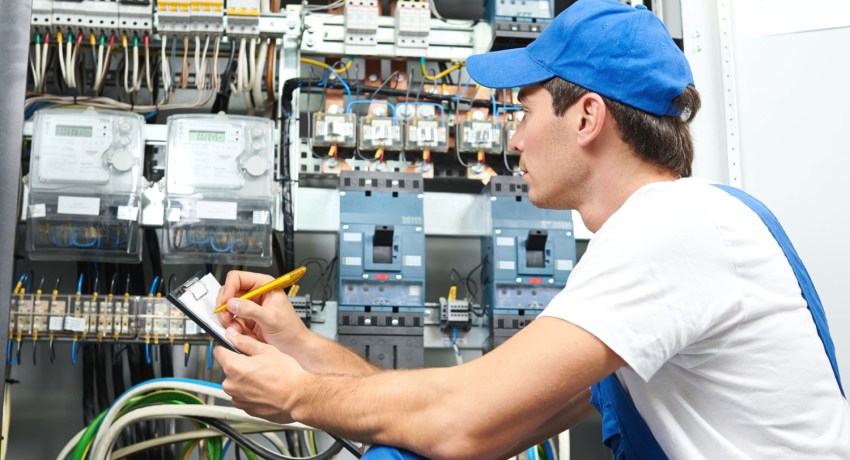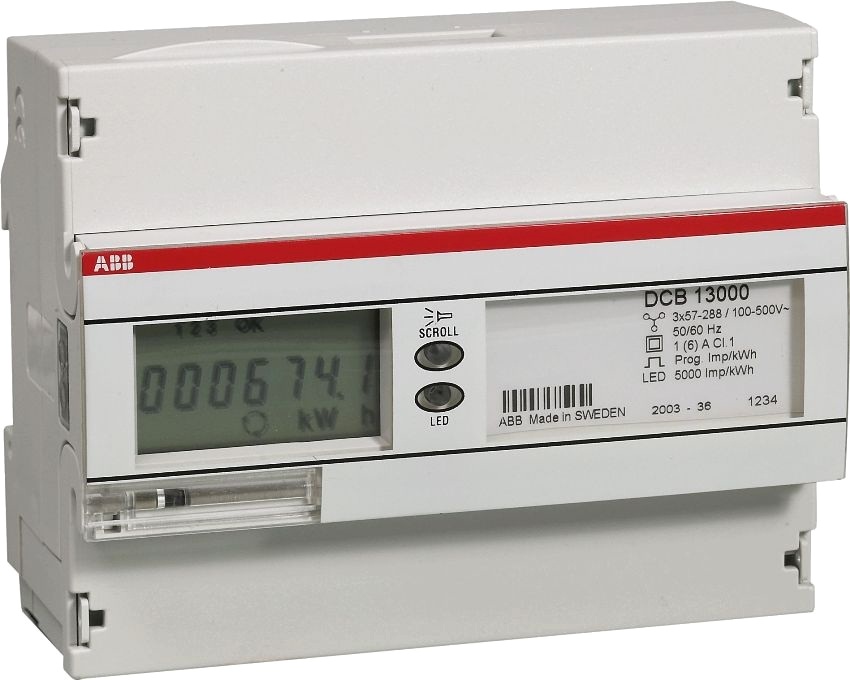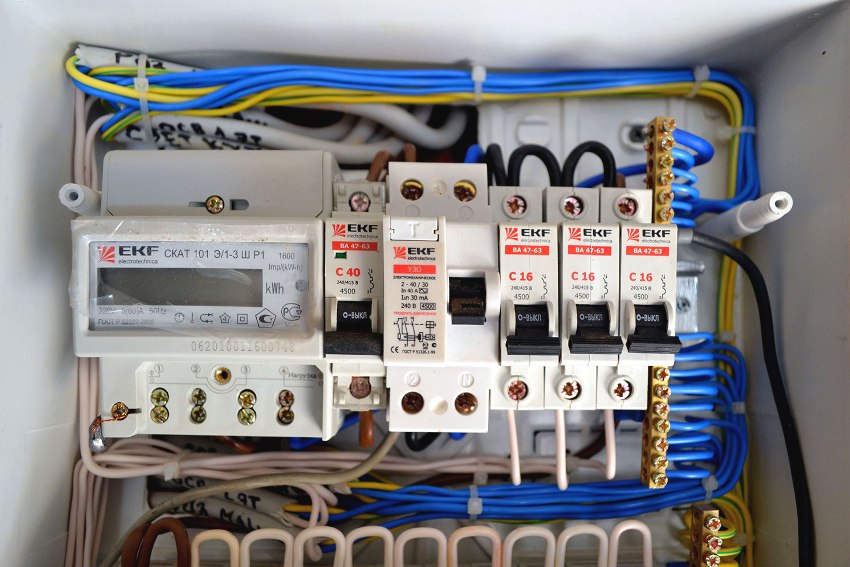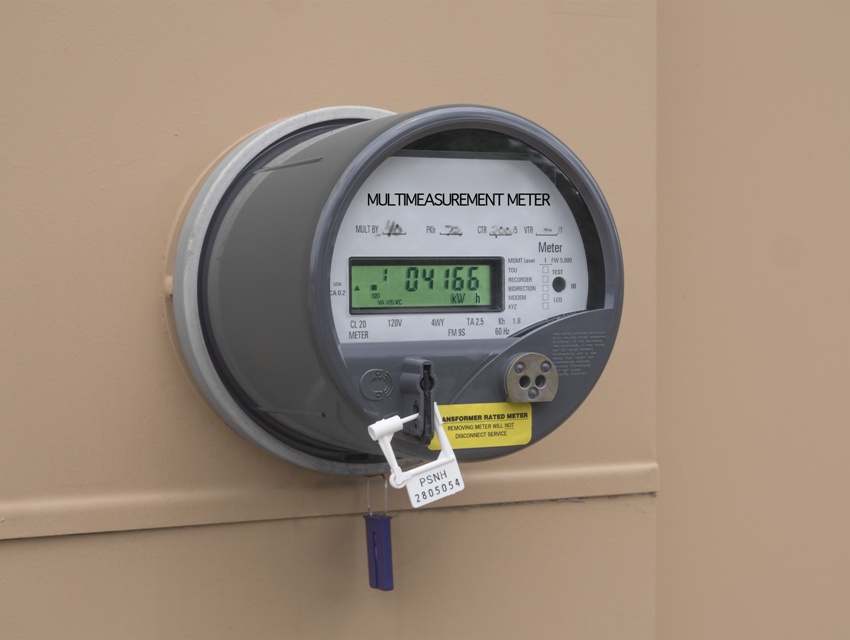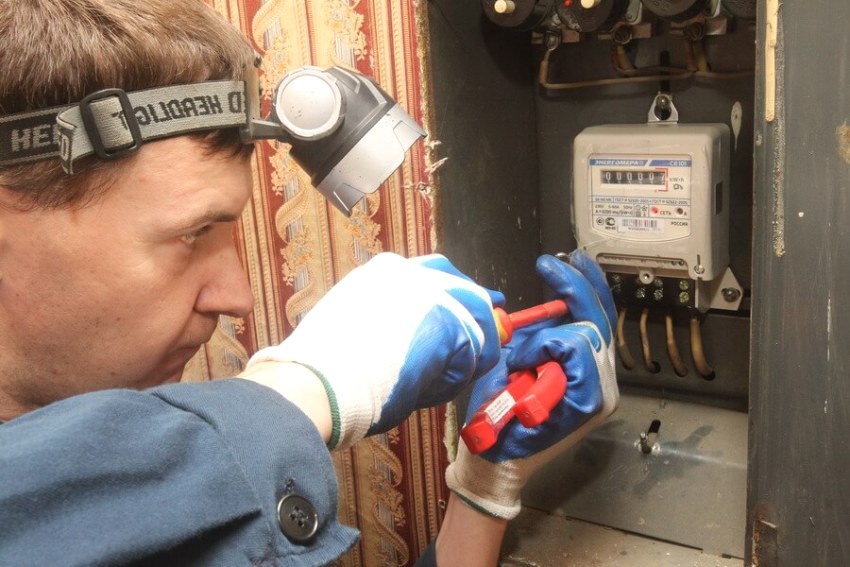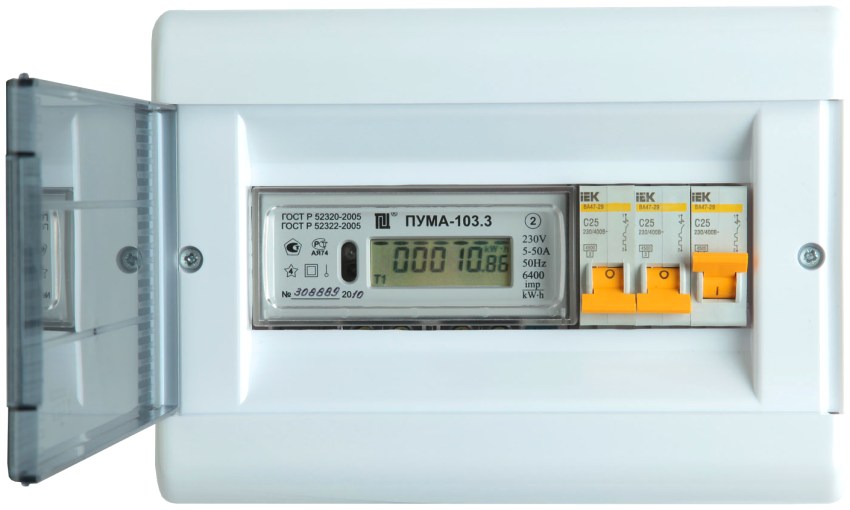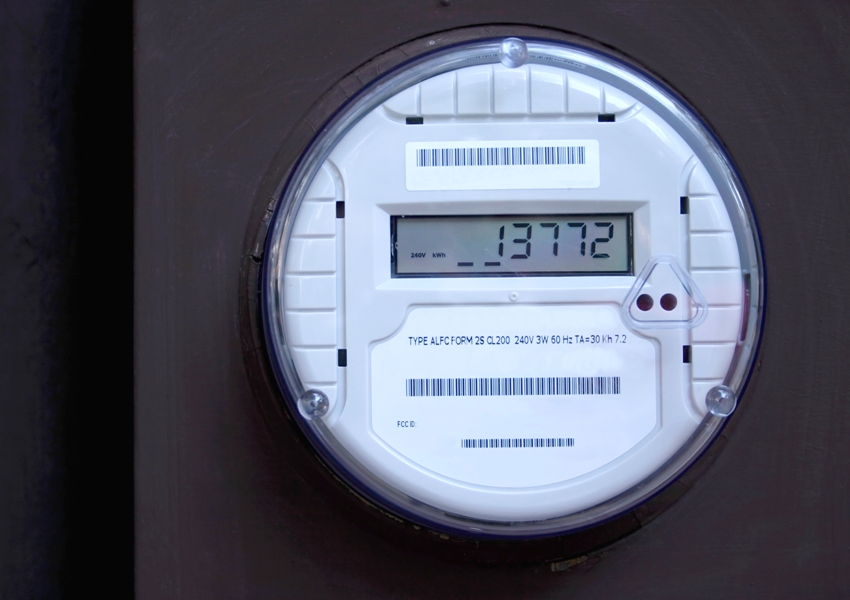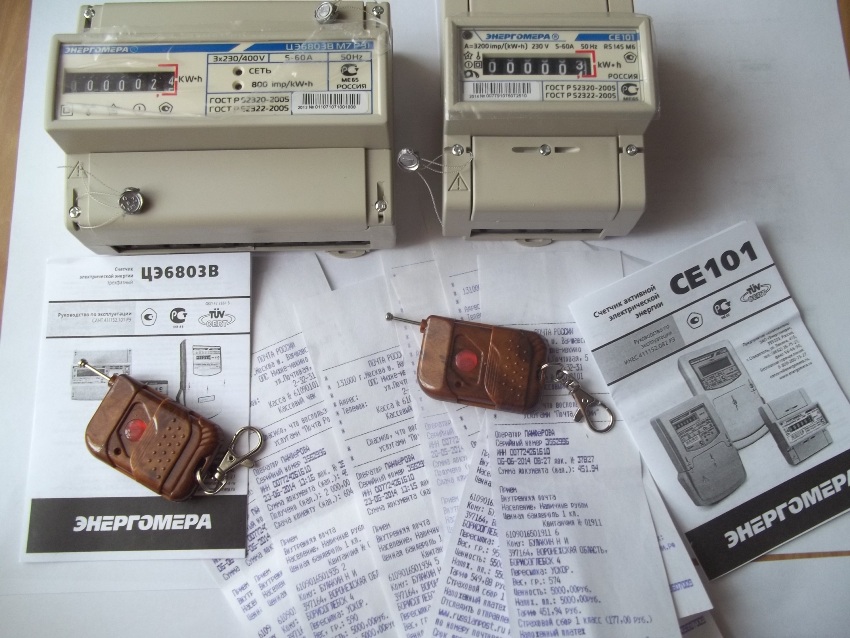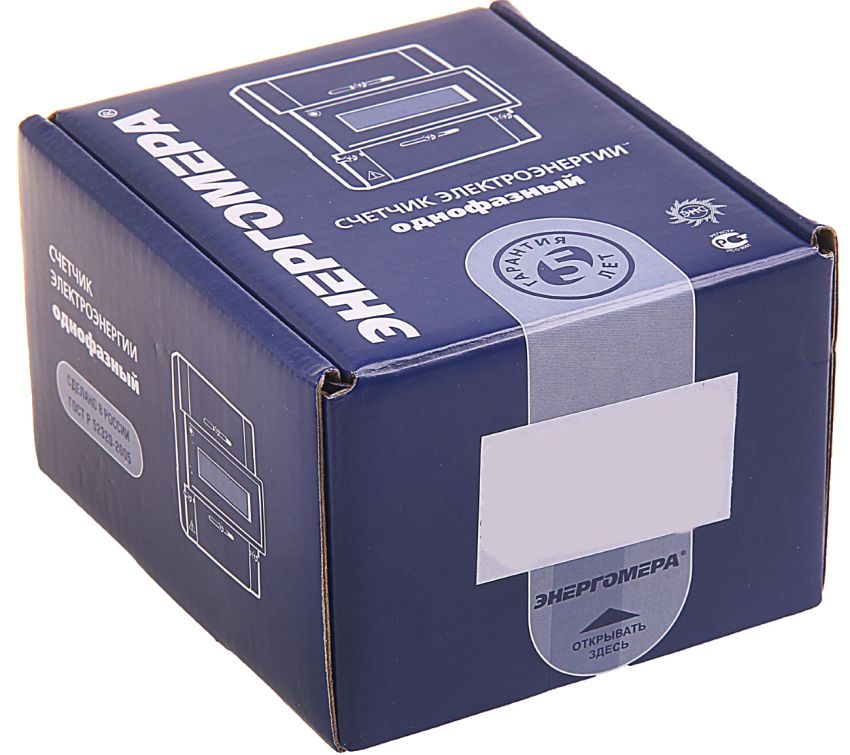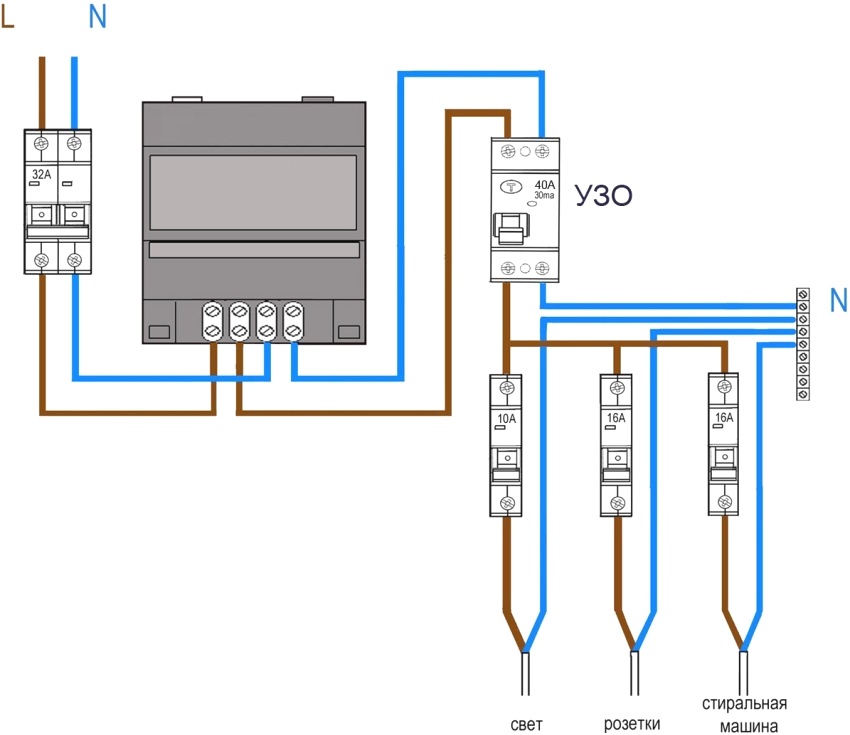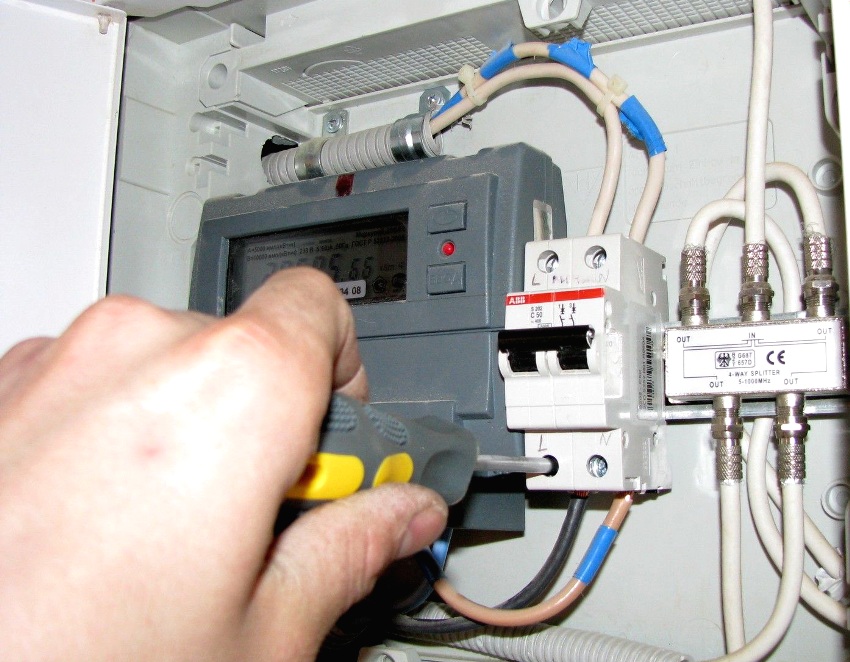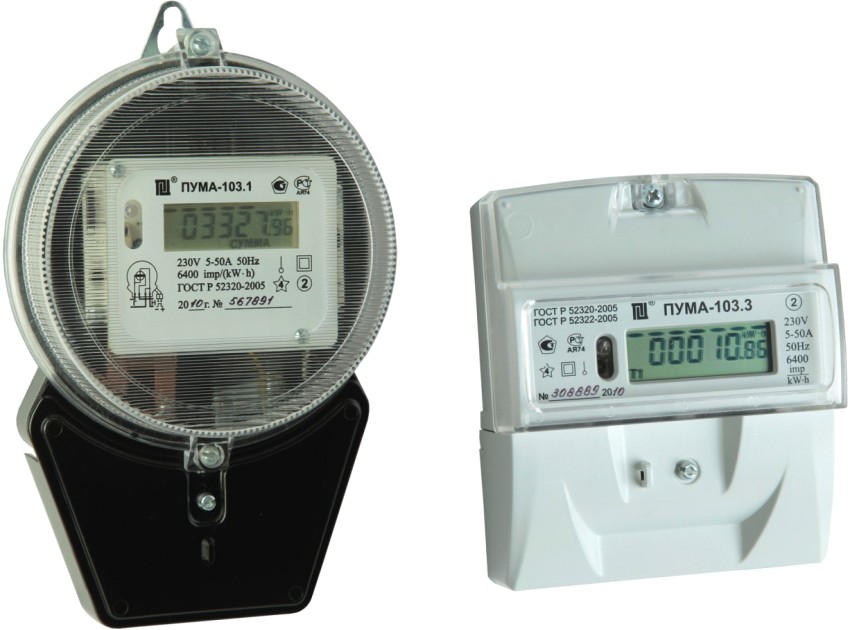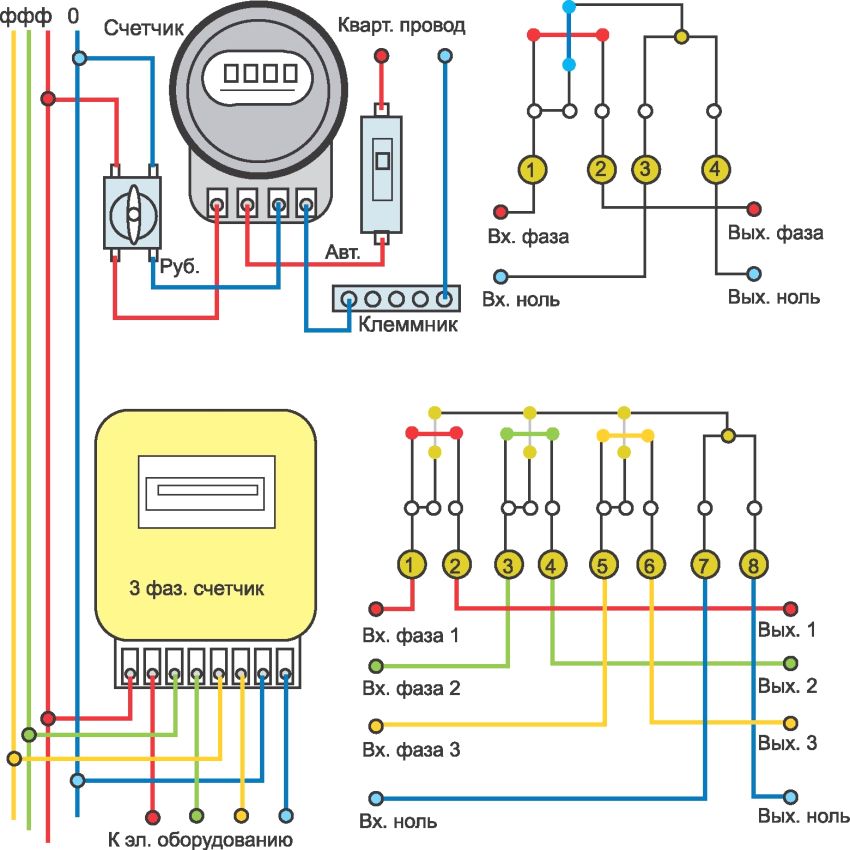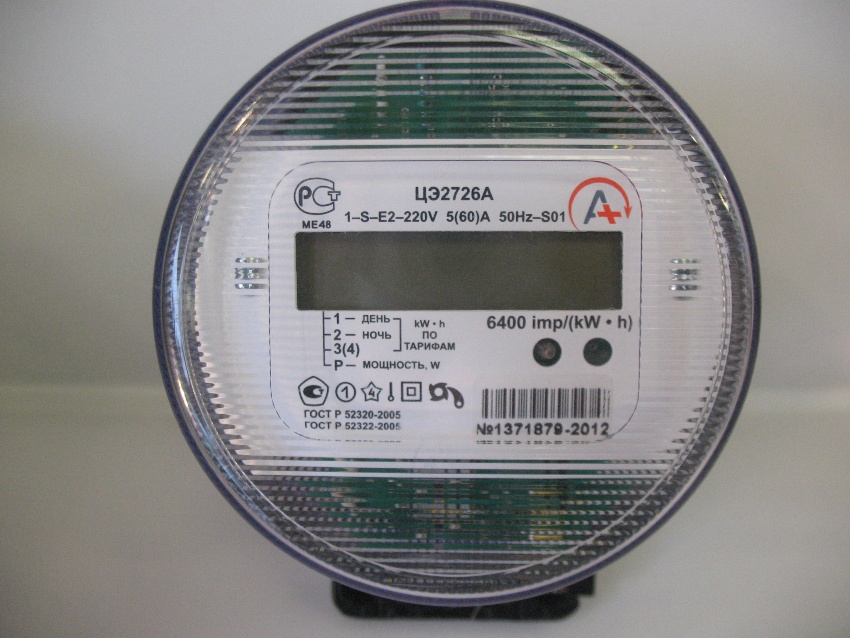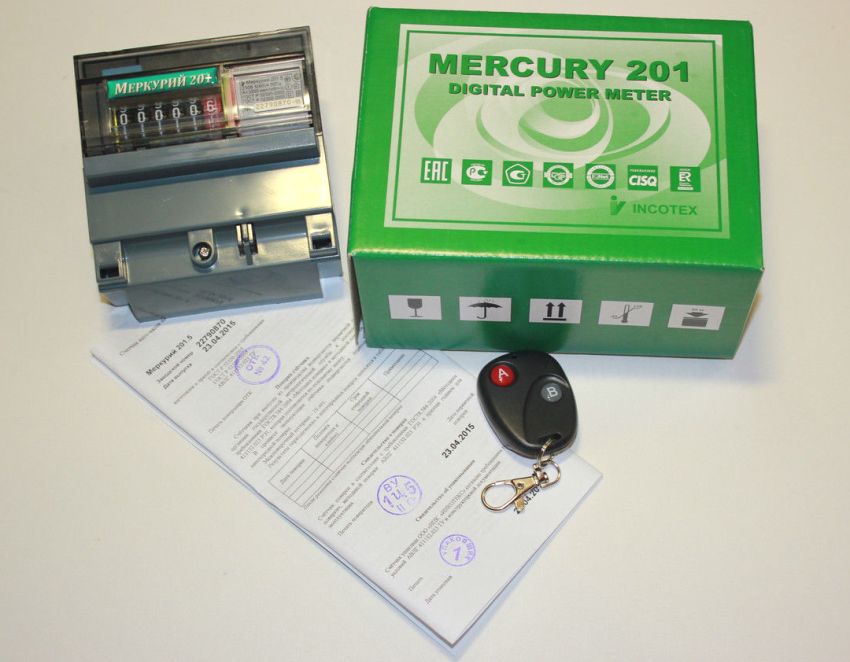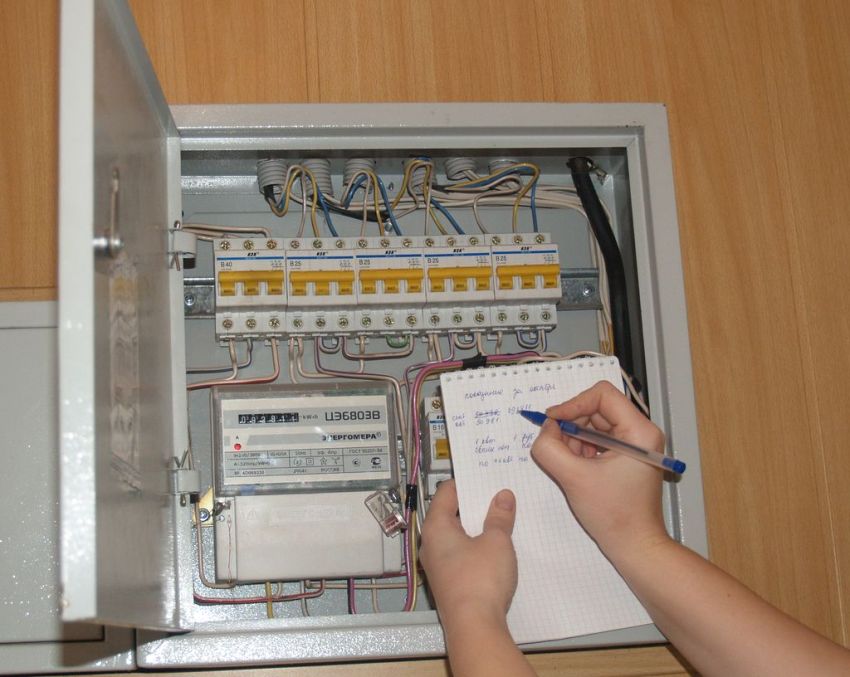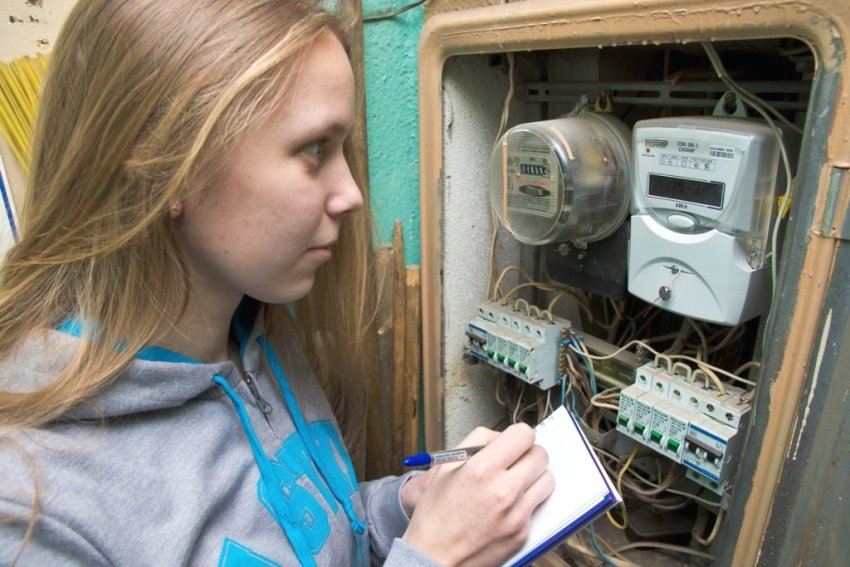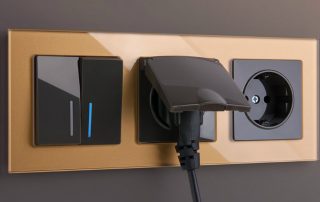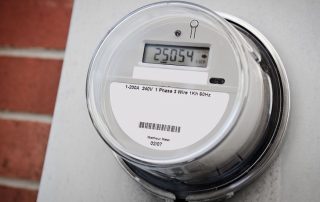From this article, you can find out the features of such a device as a two-tariff electricity meter: the main types of structures, their advantages and disadvantages, purchase prices. The text describes the procedure for installing the device and the related formalities, rules for handling counter, its verification and reading. The article discusses in detail devices with different numbers of phases and recommendations for calculating energy consumption.
Content [Hide]
- 1 Two-tariff electricity meter: device features
- 2 Two-tariff electricity meters: prices and types of designs
- 2.1 Recommendations for choosing a two-tariff electricity meter
- 2.2 Features of single-phase two-tariff meters
- 2.3 Prices of single-phase two-tariff electricity meters
- 2.4 Single-phase device connection diagram
- 2.5 Features of three-phase two-tariff meters
- 2.6 Varieties of three-phase multi-rate meters
- 2.7 Direct connection devices installation diagram
- 2.8 Indirect and semi-indirect devices: installation diagram
- 2.9 Three-phase two-tariff electricity meters: prices
- 2.10 Multi-tariff or single-tariff meter: which is better to put the device
- 2.11 How much does it cost to change the electricity meter
- 3 How to take readings from a two-tariff electricity meter
Two-tariff electricity meter: device features
With the increase in electricity tariffs in 2017, many apartment and private home owners are looking to lower their utility bill costs. There are several solutions to this problem. Some resort to the installation of modern generation energy-saving equipment. Others prefer to buy a two-tariff electricity meter, the price of which, although higher than the prices of standard devices, allows them to achieve savings during subsequent operation.
Note! In terms of external characteristics, a two-tariff type meter is practically indistinguishable from a conventional electronic device. The difference is only in its readings, which display data for night and daytime separately. Since the dimensions of the device are standard, the installation of a two-tariff electricity meter can be performed in the same place where a conventional device was previously located.
According to the updated electricity tariffs, from January 1, 2017, the population of the Moscow Region in the first half of the year will pay for 1 kW of electricity at a price of 4.81 rubles. In the second half of the year (from July 1), the cost of an energy unit will increase to 5.04 rubles.
Two-tariff electricity meters: from how long night time switches to daytime
At night, you may notice that working incandescent lamps in the house shine brighter than in the evening. This trend is especially typical for houses in rural areas located far from the transformer substation. In some cases, the differences can be so great that obtaining high-quality electricity is possible only through a voltage stabilizer.
In the interconnected energy systems, which are typical for apartment buildings, to solve this problem, it is enough to buy a two-tariff electricity meter, which is what most of the population does. The use of such devices assumes that 1 kW of electricity, depending on the time of day, will have a different cost.
In the daytime, the cost of 1 kW, wound by a two-tariff device, is slightly higher than when using a conventional meter. This period lasts from 7:00 to 23:00. Further, a preferential tariff comes into force, which allows you to significantly save energy costs. Moreover, the cost of 1 kW is several times less. This period lasts from 23:00 to 7:00.
Note! Power plants encourage consumers of electrical energy to use high-power household appliances at night. As a result, apartment owners receive savings, and power plants evenly distribute the load on the equipment, avoiding overloading during peak periods.
How two-tariff electricity meters work
The principle of operation of separate or differential billing is very simple. To understand how multi-rate devices work, you can imagine several standard meters combined in one device. Each of these units calculates electricity exclusively within its own time interval, at the end of which the next device comes into operation. In this case, the readings for each device are taken separately, calculated taking into account the tariffication, and the results are summed up.
Of course, it is impossible to organize the timely launch of several metering devices using a mechanical counter. For this reason, multi-tariff devices, including two-tariff designs, have only an electronic control option. These units are equipped with a board where all information is placed.
Multi-tariff meters have a built-in clock for convenient switching of the device between different tariff zones, as well as a memory that allows you to save this data. Most often, each zone is marked with the letter "T" with a specific numerical index. Marking "T" without a numerical index shows the total amount of consumed electricity in kilowatts. This value would be displayed by the standard counter, if set.
Helpful advice! The total figure is not needed to calculate the differential billing, but it can be used to estimate the benefit by calculating the result using the conventional system.
Advantages and disadvantages of installing two-rate meters
Why is it profitable to buy a two-tariff type electric meter:
- Significant savings in money - the cost of installing an electric meter and its purchase pays off in a year.
- Unloading power plants - power supply companies will less often resort to equipment repair, and its further operation in this mode will save fuel used to generate electricity.
- Improving the environmentally friendly environment - the amount of emissions from fuel combustion into the atmosphere is reduced due to the absence of overloads.
Most often, electricity consumers rarely ask questions about ecology and rationalization of electricity supplies, so the main advantage of two-tariff devices can be called their efficiency.
The operation of multi-tariff devices also has its drawbacks:
- Not in all regions of the country the difference between day and night tariffs is large. The cost of 1 kW of energy at night is 15% less than during the day.
- After installing an electricity meter, the cost of energy consumption will decrease only if the household appliances are used correctly. For example, it is advisable to use the dishwasher or washing machine only after 23:00.
Two-tariff electricity meters: customer reviews
Having outlined the advantages and disadvantages of two-tariff constructions, you can proceed to reviewing feedback from the forums. Some of them are listed below:
“Naturally, the savings are significant if you use electricity like my grandmother. After 23:00 she turns on the water heater, washing machine, and sometimes ironing. There is always hot water in the morning, and in the evening everything starts again. Of course, I'm not that fanatical, but I also try to stick to this system in order to save money. At least when I don't forget. "
Svetlana Strochkina, Yekaterinburg
“The whole region has installed two-tariff meters. There is no other way to keep utility bills within reason. Here we wash the whole area at night. It turns out that no one is offended. "
Georgy Makoveenko, Moscow
Note! Installing a two-tariff device may not always be advisable. In some cases, such devices can be a source of inconvenience and additional cost.
There are also negative reviews on the forms:
“The total cost of installing an electric meter in my case was 1400 rubles. Literally a month and a half later, my whole house was transferred to this type of accounting equipment. I will tell you a dubious pleasure. With a difference in payment of only 0.13 rubles. for 1 kW per month I run 12 rubles. savings. Taking into account how much electricity meters cost, it turns out that I will be able to return the money spent only after 10 years. This is despite the fact that savings are not achieved every month. Completely disappointed. "
Evgeny Dorokh, St. Petersburg
“My neighbor used it. With the promised savings, in fact, the bills run up large, if you, as a robot, do not control your every step and do not plan either washing or ironing. You will not entice me with such “pleasure”. "
Igor Skorkin, Moscow
Two-tariff electricity meters: prices and types of designs
Accounting devices with differential billing look the same as single-rate types of devices. The main differences are in the following parameters:
- the number of phases (there are three-phase two-tariff electricity meters and single-phase);
- maximum power (current) level;
- accuracy class;
- number of zones;
- type of fixation (mounting on a DIN rail or by bolting);
- presence of interfaces for communication (electricity meters with remote reading);
- type of digital display;
- additional functionality.
Note! In modern versions of multi-tariff meters, in addition to the day-night mode, additional settings are provided that allow accounting for several time zones per day and even several days per week. This gives users the opportunity to save energy on profitable days, provided that the electricity supplier provides a similar tariff.Information about this must be indicated in the contract.
Recommendations for choosing a two-tariff electricity meter
When choosing a device for the home, you should pay attention to the possibilities that the counter has. In addition to basic data, metering devices can measure:
- voltage;
- instant power consumption;
- frequency.
In some modifications there are built-in memory drives that allow you to save data on past periods, RCD and protection against power surges.
When buying a device with differential charging, it is important to clarify whether the selected model is approved by the state register. The options and parameters of the devices must comply with the current tariffication. To be sure of this, it is best to consult your local power supply company.
It is forbidden to buy metering devices from random sellers or companies with a dubious reputation. The company must necessarily have a permit to sell such equipment and relevant documentation.
Features of single-phase two-tariff meters
Single-phase two-rate meters are intended for household use. The population is gradually switching from outdated equipment to newer two-tariff equipment with electronics. Buyers give preference to domestic models.
The list of domestic manufacturers includes the following enterprises:
- Moscow plant of electrical measuring instruments;
- Concern Energomera;
- Nizhny Novgorod plant named after M.V. Frunze;
- NPF Mossar;
- Saransk instrument-making plant, etc.
Note! The model range of "Mercury" devices supports all standards applicable to accounting equipment.
A single-phase device at the output gives 220-230 V. Because of this, there are restrictions on the consumption of electricity - 7-10 kW. These devices are connected to a single-phase two-wire network. It is possible to connect to a two-phase network, but in such cases, a separate device must be provided for each phase.
Prices of single-phase two-tariff electricity meters
The prices for single-phase metering devices with two tariffs from different manufacturers are practically the same. The final cost of the device depends on the hardware store. The difference varies between 10-40%. Using the example of the table below, you can compare the prices for single-tariff and multi-tariff equipment Mercury, calculated for one phase.
Average prices for single-phase equipment Mercury:
| Device model | price, rub. |
| Single tariff devices | |
| 201.5 | 610 |
| 201.7 | 586 |
| 201.8 | 648 |
| 201.6 | 628 |
| 201.2 | 838 |
| 201.22 | 2463 |
| 201.4 | 838 |
| 202.5 | 823 |
| Multi-tariff devices | |
| 203.2T RBO | 4445 |
| 203.2T LBO | 5490 |
| 203.2T GBO | 7280 |
| 200.02 | 1660 |
| 200.04 | 2927 |
| 206 N | 1470 |
| 206 RN | 1687 |
| 206 PRNO | 2087 |
| 206 PLNO | 3533 |
The table shows how big the difference is between the price of single-tariff and multi-tariff devices calculated for one phase. Therefore, when buying a device, you need to make sure that its use will be profitable, taking into account the current tariffing of the electricity supplier, otherwise the cost of purchasing metering equipment will not pay off.
Related article:
Electricity meter readings: how to remove data from metering devices
Single-rate and multi-rate devices for electricity metering. Priority and basic rules for the transfer of evidence.
Single-phase device connection diagram
Today, two-tariff equipment is present in almost all new buildings. Therefore, most of the tenants, when moving into a new house, can immediately use all the beneficial advantages of the differential accounting system.
As for other consumers, they can turn to the State Energy Supervision Service when it is necessary to change the electricity meter, while the service life of the electricity meter does not matter.If earlier the device had to be replaced every 16 years, today, if you want to replace the accounting equipment, it is enough to write an application to the energy supply company. Specialists perform a similar procedure within one day.
Note! Some utilities offer a comprehensive service to consumers. When switching to a differential charging system, the organization will undertake the purchase of the device, its installation and configuration. You can do this procedure yourself.
Before proceeding with the self-installation of single-phase equipment, you should carefully study the instruction manual and the device connection diagram. This information can be placed in the instructions supplied with the meter, or located on the back of the terminal cover.
The terminal block has 4 pins:
- phase input;
- phase output;
- entering zero from the external network;
- zero output.
In order for the procedure to be completely safe, it is necessary to turn off the machine, plugs or switch. If the lead-in cord is fed to the meter, the line should be disconnected. When connecting wires, you need to be guided by the sequence of contacts indicated earlier.
Features of three-phase two-tariff meters
Three-phase two-tariff electricity meters Mercury 230, like similar devices of the previously mentioned manufacturers, are used mainly at enterprises where three-phase electricity is used. In addition to the function of differential electricity metering at night and daytime, these devices perform metering for each phase separately.
Some universal models provide the ability to collect data for both active and reactive energy. There are modifications that allow you to set a limiting consumption limit. After the specified amount of electricity has expired, the device automatically cuts off the mains power.
Note! It is better to entrust the installation of the meter to the hands of professionals. The specialists of the power supply company are thoroughly familiar with the design features of the devices, which allows you to perform the correct connection and avoid fines. In this case, all the requirements of the PUE are guaranteed.
The installation process of the device is as follows:
- dismantling the old device;
- installation of a three-phase multi-tariff device;
- testing the device software for operability and setting it up for the corresponding tariff plan;
- connection check;
- installation of a seal.
Varieties of three-phase multi-rate meters
There are several types of three-phase multi-rate meters on sale:
- Direct connection - the device is connected directly to the 380 or 220 V network, as is the case with single-phase devices. The throughput of such units reaches up to 60 kW. The maximum current limit is 100A. Installation of direct connection structures involves the use of wires with a small cross section.
- Semi-indirect connection - to connect devices, transformers are needed that allow them to consume energy from a high power grid. The calculation of electricity for two-tariff meters for semi-indirect switching involves identifying the difference between the current readings and the previous ones. Then the result obtained must be multiplied by the transformation ratio.
- Indirect inclusion - connected to the network through current and voltage transformers. Most often used in large factories, since structures can keep track of energy within high voltage connections.
Note! Installation of any of the listed meters is accompanied by difficulties affecting the connection procedure.A universal algorithm is used to install single-phase devices, and the connection diagrams for three-phase electricity meters can be different.
Direct connection devices installation diagram
Direct connection meters are very easy to install. Their installation scheme is in many ways similar to the algorithm for connecting single-phase devices. All the necessary information is indicated in the technical passport, which is attached to the device. In this case, it is very important to observe the order of connecting each of the wires, which differ in color. In addition, you need to monitor the placement of even and odd numbers. The procedure for connecting wires according to the diagram is given in the table.
Wire connection procedure:
| Wire number | Phase | Wire color | Connection type |
| 1 | AND | yellow | entrance |
| 2 | AND | yellow | exit |
| 3 | IN | green | entrance |
| 4 | IN | green | entrance |
| 5 | FROM | red | entrance |
| 6 | FROM | red | exit |
| 7 | zero | blue | input |
| 8 | zero | blue | exit |
Indirect and semi-indirect devices: installation diagram
Semi-indirect metering devices are connected by means of current transformers. There are many installation schemes for this equipment.
The most popular schemes:
- The ten-wire circuit is the simplest and most popular option. To make this connection correctly, you must adhere to the order of the 10 wires. From right to left, the first 3 wires are connected to phase A, then the second three wires are connected to phase B, and the next 3 are attached to phase C. The last 10th wire is neutral.
- Terminal box connections - this option is more complicated than the previous one and it involves connecting the meter using test blocks.
- The "Star" circuit is complex, but requires fewer wires than in the previous version. To begin with, the first unipolar outputs belonging to the secondary winding must be collected at a common point. The next trinity from the other exits should point towards the meter. After that, the current windings are connected.
Important! Indirect switching devices are not intended for installation in residential premises. They are used in industrial plants where highly qualified electricians are involved in the installation of equipment.
Three-phase two-tariff electricity meters: prices
Using the example of Mercury equipment in the table below, for comparison, it is indicated how much single-tariff and multi-tariff electricity meters with a three-phase connection type cost.
Average prices for equipment Mercury:
| Device model | price, rub. |
| Single tariff devices | |
| 231 AM-01 | 2024 |
| 230 AM-01 | 2196 |
| 230 AM-03 | 2196 |
| 230 AM-00 | 2196 |
| 230 AR-01 | 3791 |
| 230 AR-02 | 3791 |
| 230 AR-01 CL | 4880 |
| Multi-tariff devices | |
| 231 AT-01I | 2910 |
| 230 ART-01 CN | 4474 |
| 230 ART-00 CN | 4474 |
| 234 ART-01 P | 5578 |
| 234 ART-01 PO | 6345 |
| 234 ARTM-01 POB.R | 8856 |
| 234 ARTM-02 PB.R | 8162 |
| 234 ART-01 OL1 | 7633 |
| 236 ART-01 PQL | 5445 |
The table shows that three-phase meters with a differential metering system are much more expensive than single-rate meters. But the installation of multi-tariff equipment may not be profitable for all residential premises, just as it is not always justified to buy budget structures with one tariff.
Multi-tariff or single-tariff meter: which is better to put the device
The main difference between a three-phase device is that it is installed in a four- or three-pass AC network. The standard voltage for such a system is 380 V.
Three-phase and single-phase metering devices are used in different areas:
- Single-phase equipment is installed in residential premises and office buildings, in city apartments, garages, as well as in country houses and cottages. These devices are simple and convenient, they are distinguished by a simplified reading scheme.
- Three-phase equipment is suitable for industrial type enterprises.It can also be installed in buildings with technical equipment that consume a large amount of electrical energy. These designs are more complex, but they are characterized by high measurement accuracy.
Note! Three-phase equipment can be installed in a single-phase network.
If there is a choice between buying a single-phase device and purchasing a three-phase meter, it is better to give preference to the first one. Three-phase devices are high power and high voltage. For this reason, they require more distribution current, and their operation is dangerous if a short circuit occurs in the system.
How much does it cost to change the electricity meter
Many city apartment owners are switching to two-tariff equipment, which allows them to save money. Using the services of specialists who have the appropriate license, you can not only perform high-quality and safe installation of the device, but also reprogram the old meter to the metering mode for two tariffs, if such a function is provided in it.
Average service rates:
| Name of service | price, rub. |
| Replacement of a single-phase single-tariff device (installation and dismantling) | 2000 |
| Replacement of a single-phase multi-tariff device (installation and dismantling) | 2000 |
| Installation or replacement of current transformers (limited to 1000 V) | 3200 |
| Replacement of a three-phase direct-on device (installation and removal) | 3500 |
| Replacement of a three-phase device for indirect switching (installation and dismantling) | 3500 |
| Tariff programming | 1000 |
| Programming the device when switching to summer or winter time | 1000 |
| Mercury 200.02 (multi-tariff single-phase device) | 1800 |
| Mercury 230 ART-01 CN (multi-tariff direct connection device) | 4700 |
How to take readings from a two-tariff electricity meter
Meters with two tariffs display electricity data as accurately as possible. The information is shown on the display. Moreover, not only the total amount of energy consumed is reflected, but also the volumes of electricity used during a certain period of time, for example, day or night. Taking this into account, the owner of the apartment can draw up his own schedule for the use of powerful appliances in order to minimize the amount for paying utility bills.
Note! Metering devices with a differential billing system inform the home owner not only in relation to readings. They show the degree of load on the system, which can help to rationalize the process of energy consumption.
Some users will find the process of taking readings from a multi-tariff meter difficult due to the presence of many numerical values on the display. However, the data processing system is actually very simple when you look at it.
How to take readings from two-tariff electricity meters
To take readings from an electric meter, you will need a pen and a blank sheet of paper. The accounting device displays the letter "T" with digital marking 1, 2 or 3. The device has an "Enter" button for taking readings at different rates.
Reading scheme:
- On a piece of paper, write down the data on the daily rate (letter "T" with marking 1).
- Get readings for the night rate by pressing the "Enter" button.
- The screen will display the letter "T" marked 2. Record these readings.
- Below, record the data received for the last month.
- Based on past and received new data, calculate the amount of consumed kilowatts of electricity for the current month. To do this, subtract the readings for the last month from the latest data.
- Calculate the cost. In this case, the number of kilowatts is multiplied by the cost of 1 kW for each tariff separately.
- Add up the resulting amounts for the night and day rates.
Important! When taking readings to calculate the cost, you do not need to rewrite the digits following the decimal point.They will complicate calculations and can cause errors that result in overpayment.
How to fill out a receipt for electricity payment correctly
Not every energy supply company monitors the documentation process, so very often consumers are forced to fill out receipts on their own.
Scheme for filling in receipts:
- Bank details are entered. These data are specified in the contract for the supply of electrical energy.
- The data about the consumer is filled in, i.e. payer. The list of this information includes the consumer's address, full name and personal account number.
- The period of time for which payment will be made (month) is recorded.
- The first line of the table is intended for entering data on the daily rate "T1", both for the last month and for the current one. It also shows the rate and amount to be paid.
- The second line of the table is filled in in the same way with data on the "T2" night tariff.
- In the "Total" column, all data payable by tariffs are summarized.
Most often, the list of required information is limited to the specified data. The form of the receipt must be approved by the energy supply company. In some cases, it is required to record the model of the accounting device. At the post offices where utility bills are paid for electricity, consumers can get advice on the correct filling of receipts.
In addition, there is a hotline where you can call to resolve such issues. Many companies have resources on the Internet, where users are provided with consulting support.
Helpful advice! In some cases, it is allowed to transmit information on the electricity meter via the Internet. However, this system only works with monthly data transmission to the energy supply company.
Transmission of readings on an electric meter: basic methods
To date, several convenient systems for transmitting data through electricity meters to a service company have been developed:
- Take the data to the service company after filling out the receipt. It is advisable to pay the invoice on the same day.
- Transfer data remotely via the Internet. To do this, you need to make a calculation, go to the company's official resource on the network, log in to the site and fill out the appropriate form.
- Owners electric meters with remote reading can simply use the automatic data transfer function. By activating this option the device does not need to carry out the calculation transfer evidence to the service company. All actions are automated.
According to the updated legislation, owners of apartments in multi-storey residential buildings, as well as housing in private sectors, are not required to transmit data. All information from accounting devices can be sent in a convenient way for each consumer at the end of the month. If the owner of the meter has recently become a user of the services and does not have receipts confirming payment, it is allowed transmission of readings in an unauthorized way. In this case, e-mail, answering machine and SMS messages can be used. If you use the transfer method using SMS messages, you will definitely need a personal account number.
With this in mind, we can conclude that two-tariff meters are beneficial in most cases. At the same time, the reading system is not more complicated than that of the older generation devices.
